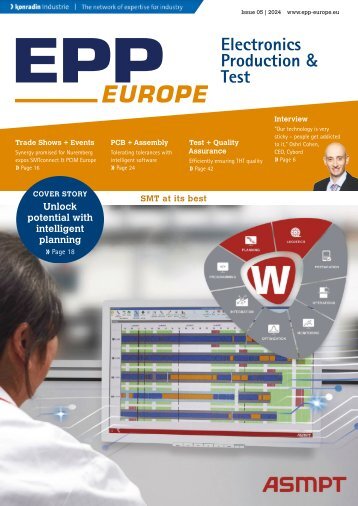EPP Europe P2.2020
- Text
- Inspection
- Assurance
- Test
- Control
- Digitization
- Counter
- Fluid
- Treatment
- Automation
- Compounds
- Production
- Expo
- Smtconnect
- Electronica
- World
COVER Enabling the Smart
COVER Enabling the Smart Factory of the future Artificial Intelligence: How far can you go? Artificial Intelligence (AI) is a buzzword often used in association with business and industrial technologies. In recent times, it has demonstrated promising potential across a variety of industries, from self-driving cars to virtual doctors. All of which, though, have been limited exclusively to the human world. However, it has far-reaching applications within the manufacturing sector too. By using the right mixture of AI technologies, manufacturers can boost their efficiency, improve flexibility, speed up processes, and even achieve self-optimizing processes. The SMT industry is no exception, which is currently facing a chronic shortage of skilled labor. While leading organizations such as IPC and SMTA are trying to address the challenge with education programs and training initiatives, it is still not enough due to lack of consideration of realities. Equipment providers like Koh Young are enabling the Smart Factory of the future by adopting AI to generate “knowledge” from “experience.” 14 EPP EUROPE November 2020
COVER The machine-to-machine (M2M) communications, guided in part by Industry 4.0, are quickly changing the manufacturing process by aggregating process data such as first pass yield and throughput. Koh Young is strengthening its large-scale datasets using the highest quality data captured through its 3D metrology expertise, then the AI algorithms necessary for smarter manufacturing processes are trained by utilizing the datasets. As part of this mission, Koh Young is dedicated to adapting AI technologies to inspection technology across a multitude of developments. What is AI? Artificial Intelligence is a multidisciplinary field of science where the goal is to create intelligent machines by making things “smarter”. Historical applications of this goal include natural language processing and translation, visual perception, pattern recognition, and decision making, but the number and complexity of applications have been quickly expanding. Out of all the advancements researchers have made, the current driver of the AI inflection point is thanks to major advances in deep learning. Source: Koh Young EPP EUROPE November 2020 15
- Page 1 and 2: 11 2020 www.epp-europe.eu INTERVIEW
- Page 3 and 4: EDITORIAL The Smart Factory of the
- Page 5 and 6: Source: Koh Young Momentum® II Pri
- Page 7 and 8: NEWS + HIGHLIGHTS The DEK TQ stands
- Page 9 and 10: NEWS + HIGHLIGHTS Appointment of Se
- Page 11 and 12: NEWS + HIGHLIGHTS Inauguration of p
- Page 13: TRADE SHOWS + EVENTS IPC Apex Expo
- Page 17 and 18: COVER to identify defects on curved
- Page 19 and 20: COVER Source: Koh Young Improve yie
- Page 21 and 22: PCB + ASSEMBLY Process capability i
- Page 23 and 24: PCB + ASSEMBLY dispensed at a posit
- Page 25 and 26: PCB + ASSEMBLY The polymerisation p
- Page 27 and 28: PRODUCT UPDATES PCB + ASSEMBLY Sold
- Page 29 and 30: PCB + ASSEMBLY Electrolube products
- Page 31 and 32: PCB + ASSEMBLY runways, gives confi
- Page 33 and 34: PCB + ASSEMBLY Source: MTEK Analysi
- Page 35 and 36: PCB + ASSEMBLY This project was loo
- Page 37 and 38: PCB + ASSEMBLY • Low cost of conv
- Page 39 and 40: PCB + ASSEMBLY Assure will count re
- Page 41 and 42: PCB + ASSEMBLY Whether sound waves
- Page 43 and 44: PCB + ASSEMBLY Source: CYGIA, China
- Page 45 and 46: PRODUCT UPDATES PCB + ASSEMBLY Intr
- Page 47 and 48: Green vapor degreasing cleaners Mic
- Page 49 and 50: Soldering solution adapts to all fu
- Page 51 and 52: Installing X-ray component counter
- Page 53 and 54: TEST + QUALITY ASSURANCE Source: Vi
- Page 55 and 56: PRODUCT UPDATES TEST + QUALITY ASSU
- Page 57 and 58: Investing in 3D AOI for THT line E.
- Page 59 and 60: Industrie The network of expertise
Inappropriate
Loading...
Mail this publication
Loading...
Embed
Loading...



















